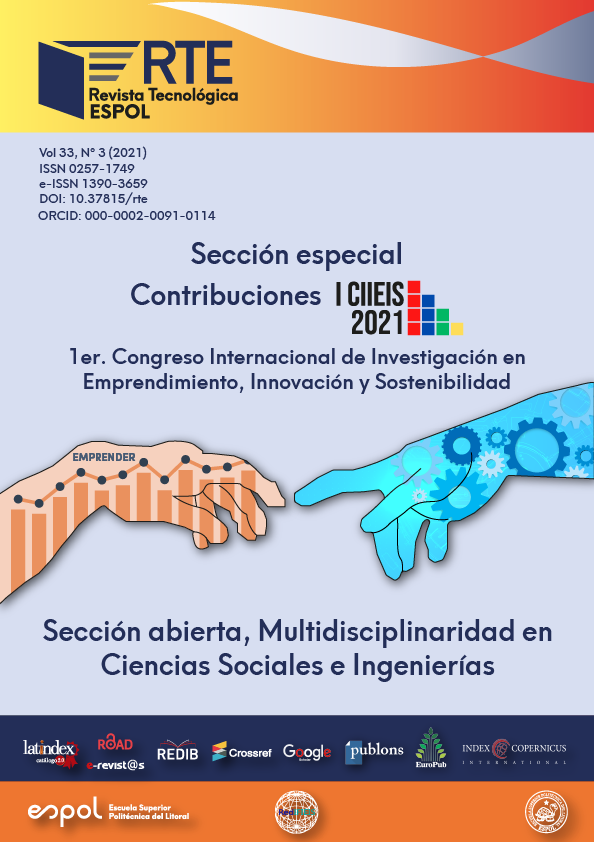The objective of this research is to study of the socio-economic and territorial characteristics of some enterprises from the districts of San Ignacio and Sabanillas, canton Acosta-Costa Rica. For this purpose, a survey was conducted among a group of entrepreneurs using the “snowball” sampling method. This method made it possible to identify various aspects of these enterprises, such as, the years of operation and the conditions of formality or semi-formality in which they have developed. Information was also obtained on these business initiatives and their entrepreneurs, such as the gender of the latter, the number of people they employ, the existence or not of government support or whether these businesses are the main source of family subsistence for their managers and, if they have taken out loans, to identify they level of indebtedness. On the other hand, we inquired about the type of clients or the effects they experienced because of COVID- 19 irruption. The results showed that it is young, qualified women between 25 and 33 years old who are the driving force behind these very varied enterprises.

This work is licensed under a Creative Commons Attribution-NonCommercial 4.0 International License.
References
Álvarez, R., y Acevedo, J. (2010). El territorio como factor del desarrollo. Semestre Económico, 13(27), 39–62.
Banco Central de Costa Rica (BCCR). (2020). Programa Macroeconómico 2019-2020.
Becker, G. S. (2009). Human capital: A theoretical and empirical analysis, with special reference to education. University of Chicago press.
Brenes, L., y Bermúdez, L. (2013). Semiformalidad de la mediana y pequeña empresa (MIPYME) en Costa Rica y su relación con la competitividad y el desarrollo. UNED Research Journal, 4(1), 101–116.
Caja Costarricense del Seguro Social (CC. SS.). (24 de mayo de 2020). CC.SS. Clasificación MiPymes. https://www.ccss.sa.cr
Capello, R. (2011). Location, regional growth and local development theories. Aestimum, 58, 1–25.
Castro, J. M., Garita, J., & Odio, M. (2015). Análisis sobre la Dinámica de Transición y Duración del Desempleo en Costa Rica. Revista de Ciencias Económicas, 32(2), 39.
Coase, R. (1994). La empresa, el Mercado y la Ley. Madrid. Alianza.
Esparcia, J., y Noguera, J. (2000). Reflexiones en torno al territorio y al desarrollo rural. El desarrollo rural en la Agenda, 9-44.
Fonseca, R., y Chaves, M. C. (2014). Política Pública, “Costa Rica Emprende”: Un análisis de los resultados. Revista de Relaciones Internacionales, 93–110.
Friedmann, J. y Douglas, M. J. (1978). Agropolitan development: toward a new strategy for regional planning in Asia, en F. Lo y K. Salih (eds.), Growth Pole Strategy and Regional Planning Development Policy. Oxford: Pergamon
Fujita, M., y Krugman, P. (2004). La nueva geografía económica: pasado, presente y futuro. Investigaciones Regionales, (4), 177–206.
Furlan, A. (2010). Actuar en la crisis: el sistema eléctrico en la perspectiva del desarrollo endógeno. Análisis de caso de la costa atlántica bonaerense, Argentina. Nadir: revista electrónica de geografía austral, 2(2).
Hernández, R. (2014). Metodología de la investigación. México: McGRAW-HILL.
Hidalgo, F. (2021). [Comunicación personal] 12 de mayo 2021.
Hirschman, A.O. (1958). The Strategy of Economic Development. USA, Yale.
Instituto Nacional de Estadística y Censo (INEC). (diciembre, 2020). Encuesta Nacional de Hogares [Base de datos]. Recuperado de https://www.inec.cr/encuestas/encuesta-continua-de-empleo
Instituto Nacional de Estadística y Censo (INEC). (2011). Censo Nacional de Costa Rica.
Jiménez, F. (2010). Crecimiento económico: Enfoques y modelos. Capítulo 5 - Teoría del crecimiento endógeno. IDEAS Working Paper Series from RePEc, IDEAS Working Paper Series from RePEc, 2010.
Lucas, R. E. (1988): On the mechanics of economic development. Journal of Monetary Economic, 22, 1:129-144
Messina, M., y Hochsztain, E. (2015). Factores de éxito de un emprendimiento: Un estudio exploratorio con base en técnicas de data Mining. Tec empresarial, 9(1), 30-40.
Ministerio de Economía Industria y Comercio (MEIC). (2014). Política de fomento al emprendimiento 2014-2018
Ministerio de Economía Industria y Comercio (MEIC). (2019). Manual para la Persona Emprendedora en Costa Rica.
Ministerio de Planificación Económica (MIDEPLAN). (2017). Índice de Desarrollo Social 2017.
Miriam, G., y Fernández, Q. (2012). Los actores en el desarrollo económico local. Un estudio en América Latina. Perspectivas, 15(30), 71–116.
Morales-Jiménez, J., Bustamante-González, Á., Vargas-López, S., Pérez-Ramírez, N., y Sereno-Pareja, O. (2015). Factores de éxito emprendedor en dos municipios de la montaña de Guerrero, México. Nova scientia, 7(15), 416-435.
Municipalidad de Acosta. (2007). Información General sobre el Cantón de Acosta.
Nelson, R. (1999): How New is New Growth Theory? Challenge, 40, 5:29-58.
O'Kelly, M., y Bryan, D. (1996). Agricultural location theory: von Thunen's contribution to economic geography. Progress in Human geography, 20(4), 457-475.
Ospina, D. (2018). Construcción de comunidades colaborativas desde el diseño y el emprendimiento endógeno. Revista Escuela de Administración de Negocios, (84), 63–77.
Pino, O. (2004). Análisis de encadenamientos productivos para la economía regional, base 1996. Theoria, 13(1).
Pole, K. (2009). Diseño de metodologías mixtas. Una revisión de las estrategias para combinar metodologías cuantitativas y cualitativas Renglones (60) http://hdl.handle.net/11117/252
Romer, M. P. (1986): «Increasing returns and long run growth». Journal of Political Economy, 94:1002- 1037
Romer, P. M. (1990). Endogenous technological change. Journal of political Economy, 98(5, Part 2), 71-102.
Rubio, C. H. (2002). La teoría del crecimiento endógeno y el comercio internacional. Cuadernos de estudios empresariales, (12), 95.
Sanabria, S., Pedraza, P., y Hurtado, E. (2014). El emprendimiento como fuente de desarrollo y fortalecimiento de las capacidades endógenas para el aprovechamiento de las energías renovables. Revista Escuela de Administración de Negocios, (77), 152–167.
Veciana J.M. (2005). La creación de empresas Un enfoque gerencial, Barcelona. p.312. https://www.uv.es/creaemp/Veciana2005Libro.pdf







